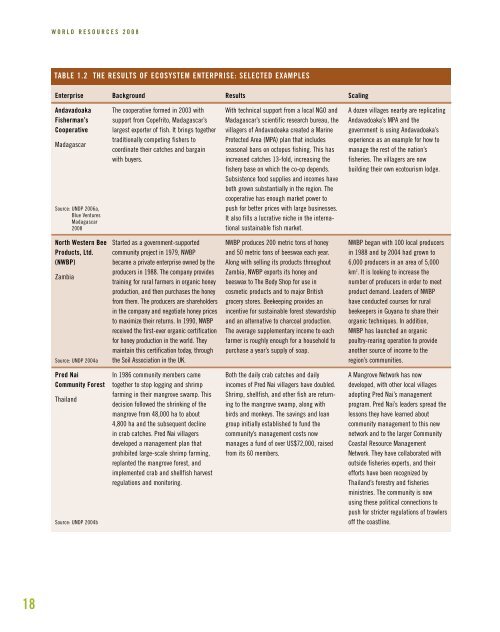Growing the Wealth of the Poor - World Resources Institute
Growing the Wealth of the Poor - World Resources Institute
Growing the Wealth of the Poor - World Resources Institute
You also want an ePaper? Increase the reach of your titles
YUMPU automatically turns print PDFs into web optimized ePapers that Google loves.
W O R L D R E S O U R C E S 2 0 0 8TABLE 1.2THE RESULTS OF ECOSYSTEM ENTERPRISE: SELECTED EXAMPLESEnterpriseBackgroundResultsScalingAndavadoakaFisherman’sCooperativeMadagascarSource: UNDP 2006a,Blue VenturesMadagascar2008The cooperative formed in 2003 withsupport from Copefrito, Madagascar’slargest exporter <strong>of</strong> fish. It brings toge<strong>the</strong>rtraditionally competing fishers tocoordinate <strong>the</strong>ir catches and bargainwith buyers.With technical support from a local NGO andMadagascar’s scientific research bureau, <strong>the</strong>villagers <strong>of</strong> Andavadoaka created a MarineProtected Area (MPA) plan that includesseasonal bans on octopus fishing. This hasincreased catches 13-fold, increasing <strong>the</strong>fishery base on which <strong>the</strong> co-op depends.Subsistence food supplies and incomes haveboth grown substantially in <strong>the</strong> region. Thecooperative has enough market power topush for better prices with large businesses.It also fills a lucrative niche in <strong>the</strong> internationalsustainable fish market.A dozen villages nearby are replicatingAndavadoaka’s MPA and <strong>the</strong>government is using Andavadoaka’sexperience as an example for how tomanage <strong>the</strong> rest <strong>of</strong> <strong>the</strong> nation’sfisheries. The villagers are nowbuilding <strong>the</strong>ir own ecotourism lodge.North Western BeeProducts, Ltd.(NWBP)ZambiaSource: UNDP 2004aStarted as a government-supportedcommunity project in 1979, NWBPbecame a private enterprise owned by <strong>the</strong>producers in 1988. The company providestraining for rural farmers in organic honeyproduction, and <strong>the</strong>n purchases <strong>the</strong> honeyfrom <strong>the</strong>m. The producers are shareholdersin <strong>the</strong> company and negotiate honey pricesto maximize <strong>the</strong>ir returns. In 1990, NWBPreceived <strong>the</strong> first-ever organic certificationfor honey production in <strong>the</strong> world. Theymaintain this certification today, through<strong>the</strong> Soil Association in <strong>the</strong> UK.NWBP produces 200 metric tons <strong>of</strong> honeyand 50 metric tons <strong>of</strong> beeswax each year.Along with selling its products throughoutZambia, NWBP exports its honey andbeeswax to The Body Shop for use incosmetic products and to major Britishgrocery stores. Beekeeping provides anincentive for sustainable forest stewardshipand an alternative to charcoal production.The average supplementary income to eachfarmer is roughly enough for a household topurchase a year’s supply <strong>of</strong> soap.NWBP began with 100 local producersin 1988 and by 2004 had grown to6,000 producers in an area <strong>of</strong> 5,000km 2 . It is looking to increase <strong>the</strong>number <strong>of</strong> producers in order to meetproduct demand. Leaders <strong>of</strong> NWBPhave conducted courses for ruralbeekeepers in Guyana to share <strong>the</strong>irorganic techniques. In addition,NWBP has launched an organicpoultry-rearing operation to provideano<strong>the</strong>r source <strong>of</strong> income to <strong>the</strong>region’s communities.Pred NaiCommunity ForestThailandSource: UNDP 2004bIn 1986 community members cametoge<strong>the</strong>r to stop logging and shrimpfarming in <strong>the</strong>ir mangrove swamp. Thisdecision followed <strong>the</strong> shrinking <strong>of</strong> <strong>the</strong>mangrove from 48,000 ha to about4,800 ha and <strong>the</strong> subsequent declinein crab catches. Pred Nai villagersdeveloped a management plan thatprohibited large-scale shrimp farming,replanted <strong>the</strong> mangrove forest, andimplemented crab and shellfish harvestregulations and monitoring.Both <strong>the</strong> daily crab catches and dailyincomes <strong>of</strong> Pred Nai villagers have doubled.Shrimp, shellfish, and o<strong>the</strong>r fish are returningto <strong>the</strong> mangrove swamp, along withbirds and monkeys. The savings and loangroup initially established to fund <strong>the</strong>community’s management costs nowmanages a fund <strong>of</strong> over US$72,000, raisedfrom its 60 members.A Mangrove Network has nowdeveloped, with o<strong>the</strong>r local villagesadopting Pred Nai’s managementprogram. Pred Nai’s leaders spread <strong>the</strong>lessons <strong>the</strong>y have learned aboutcommunity management to this newnetwork and to <strong>the</strong> larger CommunityCoastal Resource ManagementNetwork. They have collaborated withoutside fisheries experts, and <strong>the</strong>irefforts have been recognized byThailand’s forestry and fisheriesministries. The community is nowusing <strong>the</strong>se political connections topush for stricter regulations <strong>of</strong> trawlers<strong>of</strong>f <strong>the</strong> coastline.18
















